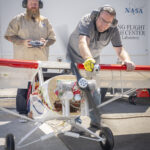Some people see a pickleball and want to smash it. When Anchal Sareen saw some pickleballs lying around a lab a few years ago, she thought about submarines and airplanes. As a mechanical engineer who studies how fluids affect movement, she couldn’t help it. So she went right out, bought a balloon and wrapped it around the pickleball. It became the inspiration for a new surface to speed and steer aircrafts and underwater drones.
The surface has dimples, like a golf ball. But they’re adjustable. Add air and the dimples smooth out. Remove air and the dimples deepen.
In a pair of recent papers, Sareen and her team at the University of Michigan in Ann Arbor have now shown how dimple depth can alter drag. Drag is the friction-like force that slows things down as they travel through a fluid. They’ve also shown how changing some — but not all — of the dimples can help steer an object through air, water or other fluids.
“That’s a cool idea,” says Christopher Douglas at Duke University in Durham, N.C. Drag is a big challenge, he says. “Anything you can do to minimize drag is great,” says this mechanical engineer who did not work on the new skin.

When some drag is good
Douglas studies fluid flow as a way to improve the systems that propel vehicles. Engineers, he notes, have long been altering surface roughness to reduce drag.
But drag isn’t always a bad thing, he adds.
Fins and rudders guide a ship by increasing drag in one place more than in another. This nudges a ship in a desired direction. And dimples might help here, too, says Sareen. She envisions vehicles that might steer by altering the texture of their skin. This could be in addition to — or even instead of — fins and rudders.
Sareen studies how to control the flow of fluids around objects to achieve a certain goal, like a reduction in drag.
For inspiration, she has looked to animals. Some swimmers, she says, change the texture of their skin to change how water flows around them. One of her favorites is the shortfin mako shark. “They’re the fastest sharks in the world,” she says. “They’re like the cheetahs of the ocean.” A shortfin mako shark can swim about 50 kilometers (30 miles) per hour, with even faster bursts.
Engineers suspect this shark’s skin is its secret to speed. It is covered with tiny toothlike scales called denticles. These denticles can change in an instant. When the shark is cruising, they all lie almost flat against its body. This can reduce its drag by about 10 percent. When the shark takes sharp turns or bends its body to navigate, the denticles move — but only on some parts of its body.
“They actually bristle, which means they lift up,” Sareen says. Denticles can lift out by as much as 50 degrees. That changes the skin’s drag and the flow of water around it. This helps the shark make quick turns. It’s also efficient because the fish doesn’t need to move a muscle.
Steering with dimples
Sareen had long been interested in applying that idea to new vehicles. Could you change their surface to affect their movement? And that’s where the balloon-covered pickleball comes in.
She showed one to a student interested in how dimples affect golf ball flight. Then she challenged him to study the link between dimples and drag.
The student and other researchers 3-D printed model spheres with different-sized dimples. They looked like giant golf balls.
They tested these plastic models in wind tunnels to identify how dimple depth affected drag.
Next, they printed hard spheres with holes. These looked like pickleballs, only larger. The researchers jacketed these holey spheres with a stretchy material. Then they attached the covered spheres to a vacuum pump. Sucking air out with the vacuum made the dimples deeper. Allowing air to flow back in made them shallower.
Making the first version of this morphable skin took about two years. It wasn’t easy, Sareen recalls. First, they had to very precisely control dimple depth with that pump. Their wind-tunnel experiments had shown that changing dimple depth by just 0.1 millimeter (0.004 inch) could reduce drag on the ball by 50 percent.
“It was very sensitive,” she says. All the air going in or out had to be controlled precisely. And that outer skin had to be made from the right material — and “absolutely leakproof,” she adds.
But those years of tests paid off.
The wind-tunnel data showed that the dimples could produce lift. That’s a force that raises a vehicle and changes its direction.
By changing the arrangement of dimples, Sareen’s team could not only control a ball’s lift but also the trajectory of its travel. That prompted them to investigate how dimples might be used as a sort of steering wheel.
“We are improving on that design as we speak,” she says. The researchers are now working on version 3.0.
Now on to ships
They’re also developing tests to see if the design would work in real-world conditions, such as the skin of some vessel sailing through air or water.
This is a critical next step. “There are many different ways to control a system,” says Douglas, at Duke. A wind tunnel is a controlled environment, he notes. In the open air or water, the effects of a dimpled skin may be more difficult to predict.
“The device or technology which could develop out of this work would be a bit more complicated than the work they’ve done in the lab,” Douglas suspects. For instance, dimpled skin could cause a vehicle to rotate. And that could make it harder to steer.
Over the next few years, Sareen’s group plans to test new prototypes in the air and water. But their inventions won’t be found on fairways, greens and sand traps.
”A lot of people have asked me, ‘Are you planning to patent this as a golf ball which can stay in the air?’” Sareen laughs and says: Not any time soon.




